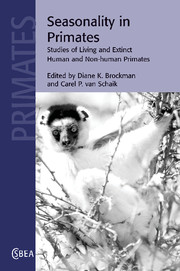Book contents
- Frontmatter
- Contents
- List of contributors
- Preface
- Part I Introduction
- Part II Seasonal habitats
- Part III Seasonality and behavioral ecology
- 3 The influence of seasonality on primate diet and ranging
- 4 Seasonality in predation risk: varying activity periods in lemurs and other primates
- 5 Physiological adaptations to seasonality in nocturnal primates
- 6 Seasonality and long-term change in a savanna environment
- 7 Day length seasonality and the thermal environment
- 8 Seasonality in hunting by non-human primates
- 9 Human hunting seasonality
- Part IV Seasonality, reproduction, and social organization
- Part V Seasonality and community ecology
- Part VI Seasonality and human evolution
- Index
- References
7 - Day length seasonality and the thermal environment
Published online by Cambridge University Press: 10 August 2009
- Frontmatter
- Contents
- List of contributors
- Preface
- Part I Introduction
- Part II Seasonal habitats
- Part III Seasonality and behavioral ecology
- 3 The influence of seasonality on primate diet and ranging
- 4 Seasonality in predation risk: varying activity periods in lemurs and other primates
- 5 Physiological adaptations to seasonality in nocturnal primates
- 6 Seasonality and long-term change in a savanna environment
- 7 Day length seasonality and the thermal environment
- 8 Seasonality in hunting by non-human primates
- 9 Human hunting seasonality
- Part IV Seasonality, reproduction, and social organization
- Part V Seasonality and community ecology
- Part VI Seasonality and human evolution
- Index
- References
Summary
Introduction
The importance of high ambient temperatures and intense solar radiation for the evolution of hominids in open savanna habitats has been the subject of considerable interest. A series of studies has considered the thermoregulatory advantages related to bipedalism (Wheeler 1991), loss of functional body hair (Wheeler 1992a), body size (Wheeler 1992b), physique (Wheeler 1993), and shade-seeking behavior (Wheeler 1994a). Furthermore, these papers have generated considerable debate (Porter 1993; Chaplin et al. 1994; Wheeler 1994b; do Amaral 1996; Wheeler 1996). It is surprising, therefore, that the importance of the thermoregulation in primate behavioral ecology has received comparatively little attention, with the body of former work focusing on other ecological factors such as food availability (Stelzner 1988). Nevertheless, a number of studies have reported primates to alter their activity schedules in response to thermoregulatory needs (baboons, Papio spp. [Stolz & Saayman 1970]; gelada, Theropithecus gelada [Iwamoto & Dunbar 1983]; pigtail macaques, Macaca nemestrina [Bernstein 1972]; sooty mangabeys, Cercocebus atys [Bernstein 1976]; chimpanzees, Pan troglodytes [Wrangham 1977]; gorillas, Gorilla gorilla [Fossey & Harcourt 1977]). However, in most cases, these studies have invoked post-hoc thermoregulatory interpretations, and few have examined explicitly the importance of the thermal environment under natural conditions.
The most detailed studies of thermoregulation in wild primates have been conducted on baboons (e.g. Stelzner & Hausfater [1986], Stelzner [1988], Brain & Mitchell [1999], Pochron [2000], and Hill [2005]).
- Type
- Chapter
- Information
- Seasonality in PrimatesStudies of Living and Extinct Human and Non-Human Primates, pp. 197 - 214Publisher: Cambridge University PressPrint publication year: 2005
References
- 18
- Cited by



